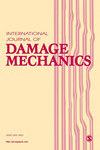考虑初始损伤和损伤演化的螺栓连接非线性流变剪切本构模型
IF 4
2区 工程技术
Q2 MATERIALS SCIENCE, MULTIDISCIPLINARY
引用次数: 2
摘要
了解螺栓连接的剪切力学机理对预测和预防地质灾害具有重要意义。目前的大多数研究很少考虑螺栓连接的流变效应。本文提出了一个综合流变本构模型,考虑了不同流变阶段的初始损伤和损伤演化以及螺栓特性。该模型包括用于瞬时变形的弹塑性Hooke体,用于衰减和稳定蠕变阶段的参数非线性Kelvin和粘性模型,以及用于加速蠕变阶段的基于时间相关剪切强度的粘塑性模型。此外,还引入了一个考虑锚杆弹性模量演变的锚杆-岩石协同变形模型。由此产生的弹粘塑性本构模型有效地描述了螺栓接头的剪切流变行为,通过与剪切蠕变试验和Maxwell模型的比较,证明了其有效性和优越性。本研究旨在为岩体工程的施工与加固提供有价值的理论指导。本文章由计算机程序翻译,如有差异,请以英文原文为准。
A nonlinear rheological shear constitutive model of bolted joints considering initial damage and damage evolution
Understanding the shear mechanics mechanism of bolted joints is of great significance for predicting and preventing geological disasters. Most current studies seldom consider the rheological effects of bolted joints. In this paper, a comprehensive rheological constitutive model is proposed, accounting for initial damage and damage evolution across different rheological stages and bolt characteristics. The model incorporates an elastoplastic Hooke body for instantaneous deformation, parametric nonlinear Kelvin and viscous models for attenuation and steady creep stages, and a visco-plastic model based on time-dependent shear strength for accelerated creep stage. Additionally, a bolt-rock cooperative deformation model is introduced, considering the evolution of the bolt's elastic modulus. The resulting elasto-viscoplastic constitutive model effectively describes the shear rheological behavior of bolted joints, with its validity and superiority demonstrated through comparisons with shear creep tests and the Maxwell model. This research aims to provide valuable theoretical guidance for the construction and reinforcement of rock mass engineering projects.
求助全文
通过发布文献求助,成功后即可免费获取论文全文。
去求助
来源期刊

International Journal of Damage Mechanics
工程技术-材料科学:综合
CiteScore
8.70
自引率
26.20%
发文量
48
审稿时长
5.4 months
期刊介绍:
Featuring original, peer-reviewed papers by leading specialists from around the world, the International Journal of Damage Mechanics covers new developments in the science and engineering of fracture and damage mechanics.
Devoted to the prompt publication of original papers reporting the results of experimental or theoretical work on any aspect of research in the mechanics of fracture and damage assessment, the journal provides an effective mechanism to disseminate information not only within the research community but also between the reseach laboratory and industrial design department.
The journal also promotes and contributes to development of the concept of damage mechanics. This journal is a member of the Committee on Publication Ethics (COPE).
 求助内容:
求助内容: 应助结果提醒方式:
应助结果提醒方式:


